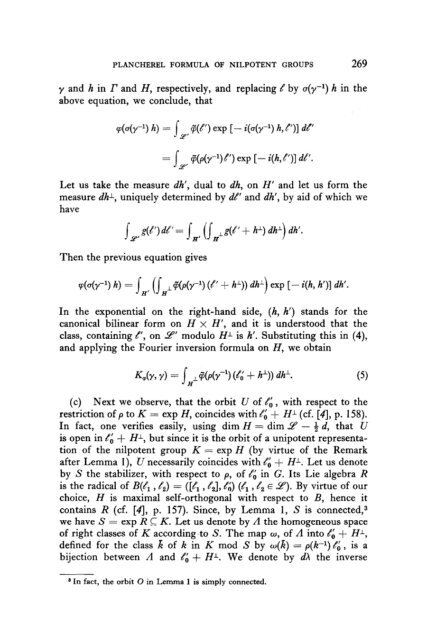On the Characters and the Plancherel Formula of Nilpotent Groups ...
On the Characters and the Plancherel Formula of Nilpotent Groups ...
On the Characters and the Plancherel Formula of Nilpotent Groups ...
You also want an ePaper? Increase the reach of your titles
YUMPU automatically turns print PDFs into web optimized ePapers that Google loves.
PLANCHEREL FORMULA OF NILPOTENT GROUPS 269<br />
y <strong>and</strong> h in I’ <strong>and</strong> H, respectively, <strong>and</strong> replacing G by a&-l) h in <strong>the</strong><br />
above equation, we conclude, that<br />
cp(u(y-l) h) = I‘,, +(I’) exp [- i(o(y-l) h, t’)] dk’<br />
= s ~, +(p(y-l) e’) exp [ - i(h, d’)] de’.<br />
Let us take <strong>the</strong> measure A’, dual to dh, on H’ <strong>and</strong> let us form <strong>the</strong><br />
measure dhl, uniquely determined by de’ <strong>and</strong> dh’, by aid <strong>of</strong> which we<br />
have<br />
Then <strong>the</strong> previous equation gives<br />
d4P) h) = IH, (/HL$%(~-l) (f’ + AL)) dhl) exp [- @, 41 dh’.<br />
In <strong>the</strong> exponential on <strong>the</strong> right-h<strong>and</strong> side, (h, h’) st<strong>and</strong>s for <strong>the</strong><br />
canonical bilinear form on H x H’, <strong>and</strong> it is understood that <strong>the</strong><br />
class, containing el, on 2’ modulo HI is h’. Substituting this in (4),<br />
<strong>and</strong> applying <strong>the</strong> Fourier inversion formula on H, we obtain<br />
(c) Next we observe, that <strong>the</strong> orbit U <strong>of</strong> r$, with respect to <strong>the</strong><br />
restriction <strong>of</strong> p to K = exp H, coincides with/i + HL (cf. [4], p. 158).<br />
In fact, one verifies easily, using dim H = dim 2’ - 4 d, that U<br />
is open in 8; + H-L, but since it is <strong>the</strong> orbit <strong>of</strong> a unipotent representa-<br />
tion <strong>of</strong> <strong>the</strong> nilpotent group K = exp H (by virtue <strong>of</strong> <strong>the</strong> Remark<br />
after Lemma l), U necessarily coincides with 6’; + HJ-. Let us denote<br />
by S <strong>the</strong> stabilizer, with respect to p, <strong>of</strong> ei in G. Its Lie algebra R<br />
is <strong>the</strong> radical <strong>of</strong> B(fl , /J = ([/1 , &,I, 8;) (tr , z$ E 9). By virtue <strong>of</strong> our<br />
choice, H is maximal self-orthogonal with respect to B, hence it<br />
contains R (cf. [4], p. 157). S ince, by Lemma 1, S is connected,3<br />
we have S = exp R C K. Let us denote by A <strong>the</strong> homogeneous space<br />
<strong>of</strong> right classes <strong>of</strong> K according-to S. The map CO, <strong>of</strong> A into 8; + H-L,<br />
defined for <strong>the</strong> class K <strong>of</strong> K in K mod S by w(R) = p(kl) 8; , is a<br />
bijection between A <strong>and</strong> 6’; + Hl. We denote by dA <strong>the</strong> inverse<br />
3 In fact, <strong>the</strong> orbit 0 in Lemma 1 is simply connected.

















